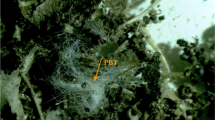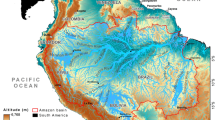Abstract
Measuring abundance of invertebrate forage for piping plovers (Charadrius melodus; hereafter plovers), a federally listed species in the USA, is an important component of research and monitoring targeted toward species recovery. Sticky traps are commonly used to passively sample invertebrates, but catch rates may vary diurnally or in response to weather. We examined diurnal variation in catch rates of invertebrates using an experiment on reservoir shoreline and riverine sandbar habitats of the Upper Missouri River in 2006 and 2008. Highest catch rates of large invertebrates (>3 mm) on dry sand habitats occurred during 08:00–11:00 Central Daylight Time (CDT) on the reservoir and 08:00–14:00 CDT on the river. On wet sand habitats, catch rates were lowest during 17:00–20:00 on both the reservoir and the river. Catch rates decreased 24% for every 10 kph increase in wind. Sticky traps deployed continuously for 12 h or more had lower catch rates than four consecutive-composited 3-hour deployments, suggesting that trap effectiveness declined for >3-hour deployments. Thus, if sticky traps are used to index plover forage abundance without controlling for time of day and wind speed, data may be highly variable or estimates could be biased.


Similar content being viewed by others
References
Agresti A (1996) An introduction to categorical data analysis. Wiley, New York
Anteau MJ, Afton AD (2009) Wetland use and feeding by lesser scaup during spring migration across the upper Midwest, USA. Wetlands 29:704–712
Backwell PRY, O’Hara PD, Christy JH (1998) Prey availability and selective foraging in shorebirds. Animal Behaviour 55:1659–1667
Catlin DH (2009) Population dynamics of piping plovers (Charadrius melodus) on the Missouri River. Ph.D. Dissertation. Virginia Polytechnic Institute and State University, Blacksburg, VA, USA
Cuthbert FJ, Scholtens B, Wemmer LC, McLain R (1999) Gizzard contents of piping plover chicks in Northern Michigan. Wilson Bulletin 111:121–123
Davis CA, Smith LM (2001) Foraging strategies and niche dynamics of coexisting shorebirds at stopover sites in the southern Great Plains. Auk 118:484–495
Elias SP, Fraser JD, Buckley PA (2000) Piping plover foraging ecology on New York barrier islands. Journal of Wildlife Management 64:346–354
Haig SM, Elliott-Smith E (2004) Piping Plover. In: Poole A (ed) The Birds of North America. Cornell Laboratory of Ornithology, Ithaca
Houghton LM (2005) Piping plover population dynamics and effects of beach management practices on piping plovers at West Hampton Dunes and Westhampton Beach, New York. Ph.D. Dissertation. Virginia Polytechnic Institute and State University, Blacksburg, VA, USA
Idris AB, Grafius E (1998) Diurnal flight activity of Diadegma insulare (Hymenoptera: Ichneumonidae), a parasitoid of the diamondback-moth (Lepidoptera: Plutellidae), in the field. Environmental Entomology 27:406–414
LaPierre LM (2000) Prey selection and diurnal activity of Holcocephala oculata, (F.) (Diptera: Asilidae) in Costa Rica. Proceedings of the Entomological Society of Washington 102:643–651
Lee JF (2007) Community composition and microhabitats of macroinvertebrates on sandbars within the Lower Missouri River as a food source for foraging migrating shorebirds. M.S. Thesis. South Dakota State University, Brookings, SD, USA
Le Fer D (2006) Piping plover foraging ecology in the Great Plains. Ph.D. Dissertation. Virginia Polytechnic Institute and State University, Blacksburg, VA, USA
Le Fer D, Fraser JD, Kruse CD (2008) Piping plover chick foraging, growth, and survival in the Great Plains. Journal of Wildlife Management 72:682–687
Loegering JP, Fraser JD (1995) Factors affecting piping plover chick survival in different brood-rearing habitats. Journal of Wildlife Management 59:646–655
Mundie JH (1959) The diurnal activity of larger invertebrates at the surface of Lac La Ronge, Saskatchawan. Canadian Journal of Zoology 37:945–956
Murkin HR, Abbott PG, Kadlec JA (1983) A comparison of activity traps and sweep nets for sampling nektonic invertebrates in wetlands. Freshwater Invertebrate Biology 2:99–106
Nordstrom LH, Ryan MR (1996) Invertebrate abundance at occupied and potential piping plover nesting beaches: Great Plains alkali wetlands vs. the Great Lakes. Wetlands 16:429–435
Rundle WD (1982) A case for esophageal analysis in shorebird food studies. Journal of Field Ornithology 53:249–257
Shaffer F, Laporte P (1994) Diet of piping plovers on the Magdalen Island, Quebec. Wilson Bulletin 106:531–536
Sherfy MH, Kirkpatrick RL, Richkus KD (1999) Evaluation of a modified activity trap for invertebrate sampling in shallow wetlands. Wildlife Society Bulletin 27:997–1003
Sherfy MH, Stucker JH, Anteau MJ (2009) Missouri River emergent sandbar habitat monitoring plan – a conceptual framework for adaptive management. USGS Open-File Report 2008–1223
US Fish and Wildlife Service (1985) Endangered and threatened wildlife and plants: determination of endangered and threatened status for the piping plover; final rule. Washington, DC, Federal Register 50:50726–50734
US Fish and Wildlife Service (2003) U.S. Fish and Wildlife Service (2003) Amendment to the 2000 Biological Opinion on the Missouri River Main Stem Reservoir System, Operation and Maintenance of the Missouri River Bank Stabilization and Navigation Project, and Operation of the Kansas River Reservoir System. U.S. Fish and Wildlife Service, Washington
Acknowledgments
We are grateful for financial support provided by the Missouri River Recovery Program through the Threatened and Endangered Species Program and the Garrison Project Office of the Omaha District, US Army Corps of Engineers and support provided by Northern Prairie Wildlife Research Center (NPWRC) and the NPWRC Missouri River Least Tern and Piping Plover Research Team. Specifically, we thank Ray Buchheit, Alex Coll, Colin Dovichin, Sean Iverson, Nickolas Smith, Melissa VanderLinden, and Mark Wiltermuth for conducting the experiment in the field, and Phil Brown, Deb Buhl, Kelly Crane, Coral Huber, Casey Kruse, Michael Morris, Marsha Sovada, Terry Shaffer, Larry Strong, and Jennifer Stucker for support. Lastly, we are indebted to Dave Mushet, Aaron Pearse, and anonymous reviewers for helpful comments that improved the manuscript. Use of trade names is for informational purposes only and does not imply U.S. Government endorsement.
Author information
Authors and Affiliations
Corresponding author
Rights and permissions
About this article
Cite this article
Anteau, M.J., Sherfy, M.H. Diurnal Variation in Invertebrate Catch Rates by Sticky Traps: Potential for Biased Indices of Piping Plover Forage. Wetlands 30, 757–762 (2010). https://doi.org/10.1007/s13157-010-0066-2
Received:
Accepted:
Published:
Issue Date:
DOI: https://doi.org/10.1007/s13157-010-0066-2




